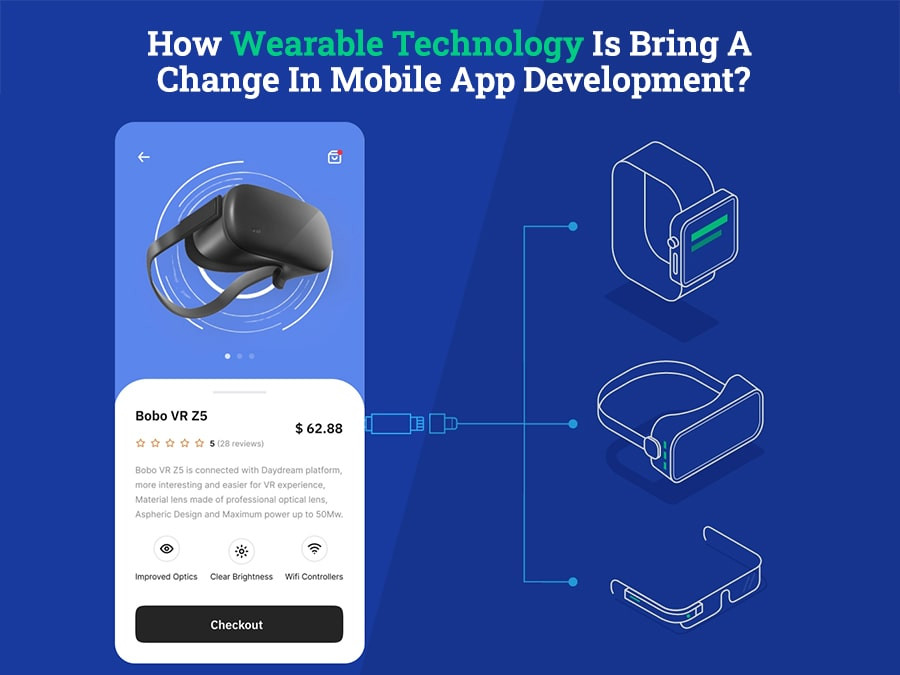Mobile app development companies always go above and beyond to make our life easier by providing us with a robust solution. But the advent of wearable technology has revolved around the things and demand for custom mobile apps that are seamlessly compatible with wearable devices.
In recent years, wearables have become a buzzword of the town and are influencing businesses from almost every sector such as healthcare, entertainment, gaming, fashion, fitness, tourism and more. Due to the surging usage of wearables in such industries, the urge for developing a custom mobile application for these wearables is also increasing at a rapid pace.
But before understanding the things that you need to change or integrate into the future mobile apps for the wearables, let’s first understand what exactly wearable devices are…
Understanding the Basics: What is Wearable Technology?
Wearable Technology is nothing but sensor-based devices that are designed to track and analyse the personal data collected by wearable devices. With the advent of technology and innovations in wearable devices, at present it can be used for wide purposes including heart rate, blood pressure, temperature, step counts, calories burn and more. In fact, in certain cases, the devices embedded with BCG and ECG, allow users to analyse the blood oxygen saturation and the condition of the patients. Of course, this feature will be available on a few super high tech devices.
But coming back to the wearable devices that have become a trendsetter these days may include shoes, Google Glasses, Apple Smart Watches, VR headsets, car seats, mattresses and what not. Small sensors or microchips can be installed in every possible atmosphere.
Before we proceed further, many of you are wondering what’s the magic mantra behind this wearable technology and how these devices work…
Here we go!
How Do Wearable Devices Work: Understanding the Functionality of Wearables
Are you in the dilemma of how these wearable devices can help you track personal data?
The wide variety of wearables are controlled by the apps installed in smartphones which helps you collect the data from the devices and provide complete insights in the simplest way.
Further, the wearables are connected with the Bluetooth, Wi-Fi or cellular network that helps in transforming the device’s data to the mobile app. The app empowered wearable devices using sensors to collect data from the hardware and process it to provide the desired output on the app.
Basically, the wearable device functions much like your smartphone, but with a better functional and logistical appeal.
This is the reason that wearable devices are taking the momentum and staying here to rule the domain.
You don’t need to trust our words, here are a few surprising facts or market statistics that represent the real picture of wearables and their market..
“According to the report from Gartner, there will be 36 billion devices that have been connected by 2020.”
“The report of Statista says that in the coming year the number of users in the wearable segment will reach around 441.5 million.”
So if you are a business enthusiast planning to become a part of this thriving industry, then grab the opportunity by hiring a mobile app development company. But before proceeding with the app development process, you need to understand how to make your mobile app compatible with wearables…
Now the question is what kind of changes and improvements is demanded in mobile app development?
The Impact of Wearable Technology on Mobile App Development
So this way wearables are enforcing a lot of changes and opportunities in the development of future mobile applications..
Here’s how mobile applications are changing or impacting due to wearables:
- Seamless Data Transmission With BLE Standard
In the age of digitization, people are more inclined to use WI-FI or cellular network connection and have completely forgotten about Bluetooth connectivity.
However, when developing a mobile app for wearables, considering the Bluetooth protocol for the seamless yet secure data transmission between your wearables and smartphone devices is one of the most important considerations.
Why…
Firstly, it provides effective connectivity when your device loses the internet connection.
Secondly, it provides energy-consuming reliable transmission as it uses more stationary power than battery power.
To leverage its convenience, mobile app developers can use one of the best communication protocols that are Bluetooth Low Energy (BLE) standard.
- Embracing Accurate GPS Technology
Did you know who uses these wearable devices the most? The people who belong to sports and travelling are using these wearable devices the most.
In that case, expecting and having accurate GPS functionality in the modern app will lead to a positive user experience. The integration of the industry best GPS technology in future mobile apps will allow users to identify the right destinations while travelling across the borders and enables them to collect the data from the exact location.
- Integrate Progressive Interactive Features
It would be great if the future version of mobile apps for the wearables will be offering advanced communication features such as answering or attending voice calls by just tapping or swiping on the screen.
Adding these extraordinary features to your app will encourage a large number of users to move towards wearables.
Conclusion
The need for wearable devices will keep increasing though lead to the demand for custom app development solutions. But hiring React Native programmers will help you customize the app embracing all such major changes and make your wearable apps with proper efficiency and pertinent features.
